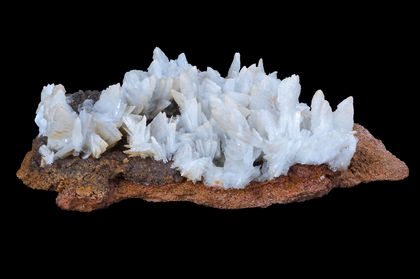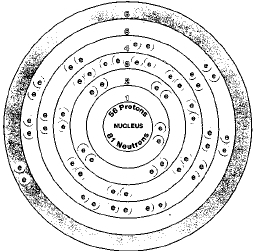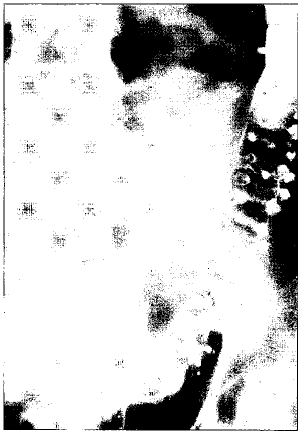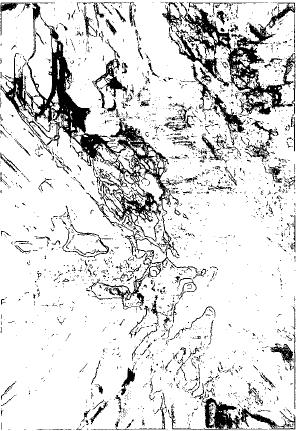BARIUM


Overview
Barium was first isolated in 1808 by English chemist Sir Humphry Davy (1778-1829). In 1807 and 1808, Davy also discovered five other new elements: sodium, potassium, strontium, calcium, and magnesium. All of these elements had been recognized much earlier as new substances, but Davy was the first to prepare them in pure form. (See sidebar on Davy in the Calcium entry.)
Barium had first been identified as a new material in 1774 by Swedish chemist Carl Wilhelm Scheele (1742-86). The form with which Scheele worked, however, was a compound of barium, barium sulfate (BaSO 4 ). Barium sulfate is, in fact, the most common naturally occurring ore of barium. It is generally known as barite or barytes.
SYMBOL
Ba
ATOMIC NUMBER
56
ATOMIC MASS
137.34
FAMILY
Group 2 (IIA)
Alkaline earth metal
PRONUNCIATION
BARE-ee-um
Barium is a member of the alkaline earth metals. The alkaline earth metals make up Group 2 (IIA) of the periodic table. The other elements in this group are beryllium, magnesium, calcium, strontium, and radium. These elements tend to be relatively active chemically and form a number of important and useful compounds. They also tend to occur abundantly in the Earth's crust in a number of familiar minerals such as aragonite, calcite, chalk, Limestone, marble, travertine, magnesite, and dolomite. Alkaline earth compounds are widely used as building materials.
Barium itself tends to have relatively few commercial uses. However, its compounds have a wide variety of applications in industry and medicine. Barium sulfate is used in X-ray studies of the gastrointestinal (GI) system. The GI system includes the stomach, intestines, and associated organs.
Discovery and naming
The first mention of barium compounds goes back to the early seventeenth century. Early records mention a "Bologna stone," named for the the city of Bologna, Italy. The Bologna stone glowed in the dark.
For more than a hundred years, researchers labored without being able to identify the elements in the stone. In 1774, Scheele announced the presence of a new element in the Bologna stone. Today, scientists know that the stone was a form of barite. Five years later, Scheele demonstrated that barite was also present in heavy spar. This dense transparent mineral closely resembles ordinary spar, a compound of calcium.
Physical properties
Pure barium is a pale yellow, somewhat shiny, somewhat malleable metal. Malleable means capable of being hammered into thin sheets. It has a melting point of about 700°C (1,300°F) and a boiling point of about 1,500°C (2,700°F). Its density is 3.6 grams per cubic centimeter.
When heated, barium compounds give off a pale yellow-green flame. This property is used as a test for barium.
Chemical properties
Barium is an active metal. It combines easily with oxygen, the halogens, and other non-metals. The halogens are Group 17 (VIIA) of the periodic table and include fluorine, chlorine, bromine, iodine, and astatine. Barium also reacts with water and with most acids. It is so reactive that it must be stored under kerosene, petroleum, or some other oily liquid to prevent

Occurrence in nature
Barium is the fourteenth most abundant element in the Earth's crust. Its abundance is estimated to be about 0.05 percent.
The most common sources of barium are barite and witherite. Witherite is an ore containing barium carbonate (BaCO 3 ). The world's major sources of barium ores are China, India, Morocco, the United States, Turkey, and Kazakhstan. Most of the barium

Isotopes
There are seven naturally occurring isotopes of barium: barium-130, barium-132, barium-134, barium-135, barium-136, barium-137, and barium-138. Isotopes are two or more forms of an element. Isotopes differ from each other according to their mass number. The number written to the right of the element's name is the mass number. The mass number represents the number of protons plus neutrons in the nucleus of an atom of the element. The number of protons determines the element, but the number of neutrons in the atom of any one element can vary. Each variation is an isotope.
About a dozen radioactive isotopes of barium are known also. A radioactive isotope is one that breaks apart and gives off some form of radiation. Radioactive isotopes are produced when very small particles are fired at atoms. These particles stick in the atoms and make them radioactive.
None of the isotopes of barium has any practical commercial application.
Extraction
Pure barium is produced by reacting barium oxide (BaO) with aluminum or
silicon:
Uses
Barium metal has relatively few uses because it is so active. This activity makes it an excellent "getter" or "scavenger" when removing unwanted oxygen from sealed glass containers. (Oxygen can interfere with the operation of a vacuum tube, for example.) By adding a small amount of barium to the tube, the free oxygen inside will be "soaked up." The oxygen reacts with the barium to form barium oxide.
Compounds
Compounds of barium, especially barite (BaSO 4 ), are critical to the petroleum industry. Barite is used as a weighting agent in drilling new oil wells. A weighting agent is a material that adds body to petroleum.
Drilling for oil used to produce huge gushers. A gusher is an oil that sprays out of the well into the air. Gushers are undesirable, because they waste oil and can burn for months if ignited.
Gushers are caused by the pressure of oil rushing into a newly drilled hole in the ground. This pressure pushes the oil upward much too rapidly. Barite is added to the hole as it is drilled. There, it tends to mix with oil in the ground and form a very dense mixture that comes out much more slowly and under control.
Ninety percent of the barite mined in the United States is used by the petroleum industry. Here are other uses of barite and other barium compounds:
Taking a look inside the body
P erhaps the best known use of barium compounds is in medicine. Doctors often want to know what is happening inside a patient's body. One way to find out, of course, is through surgery. But surgery is a drastic procedure. It can cause new problems for the patient. As a result, medical researchers have developed procedures that are less extreme. One such method is called radiography.
Radiography is a technique in which X rays are passed through the body. X rays are high energy light waves. They can pass through skin and tissue, but are absorbed by bones. So X rays are a good way of finding out if a bone is broken, for example.
Any type of light appearing on film from an X ray produces a black area, or exposure. The X rays pass through soft issues, exposing the film. Bones look greyish white on the film, depending on how much energy gets through.
Radiography can be also be used for studying parts of the body where bones are not involved. For example, a doctor might want to study a person's stomach. Since there are no bones in the stomach, some other method must be used to see inside the stomach.
Barium sulfate is often used in such cases. Barium sulfate has some of the same properties as bony material. Therefore, since X rays will not pass through barium sulfate, this compound can be used to examine certain soft tissues.
Radiography using barium sulfate is called a barium swallow or a barium enema. Barium sulfate is mixed with water into a slurry (mixture) that looks and tastes like ground-up chalk. The patient swallows the dense mixture. A doctor or nurse then holds a fluoroscope over the patient's abdomen. The fluoroscope emits X rays that show up on a television screen.
The barium sulfate-water mixture slowly travels down the patient's throat, into the stomach, through the intestines, and out through the bowels. As the barium sulfate coats the lining of the digestive tract, a doctor can see if anything is wrong.
How can a toxic compound like barium sulfate be used for this procedure? Barium sulfate does not dissolve in water. So it cannot enter the blood stream. If it cannot get into the blood, it has no toxic effects. The barium sulfate is eliminated through the bowels a few hours after the procedure.
barium sulfate (barite): used to add body to or as a coating for paper products; as a white coloring agent in paints, inks, plastics, and textiles; in the manufacture of rubber products; in the production of batteries; in medical applications (see accompanying sidebar)
barium carbonate (BaCO 3 ): used in the production of chlorine and sodium hydroxide; as rat poison; in special types of glass
barium oxide (BaO): used to remove water from solvents; in the petroleum industry
barium nitrate (Ba(NO 3 ) 2 ): used in fireworks; as rat poison; in special ceramic glazes
Health effects
Barium and all of its compounds are very toxic.
Comment about this article, ask questions, or add new information about this topic: